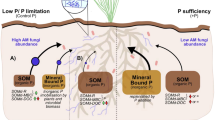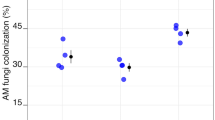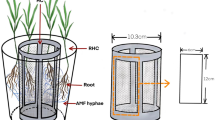Abstract
In the context of a changing climate, there has been an increased research focus on predicting the response of plants to elevated atmospheric CO2 concentrations. Simultaneously, the availability of phosphate fertiliser is becoming increasingly limited. Although the effects of climate change on arbuscular mycorrhizal fungi (AMF) have been given some attention, it has not been possible to generalise effects of AMF confidently across plant functional groups such as C3 and C4 plants. We grew the C4 cereal Zea mays cv. B73 with or without inoculation with the AMF Funneliformis mosseae, at three different soil P concentrations ranging from 0 to 90 mg P kg−1 soil, and at ambient (400 ppm: aCO2) or elevated (900 ppm: eCO2) CO2 concentrations. Plant biomass, shoot P nutrition, and colonisation by AMF were analysed. With limiting soil P, plant growth responded positively to colonisation by AMF, but not eCO2. At the medium soil P treatment, shoot P concentration but not growth was increased by AMF colonisation, while growth was instead increased by eCO2. The positive growth response to eCO2 persisted at the highest soil P treatment, where there were no effects of AMF colonisation on plant growth or P nutrition. The effects of AMF colonisation and CO2 on maize growth and P nutrition in a future climate scenario will likely be highly dependent on the availability of soil P. Furthermore, differential effects on plants of contrasting functional groups (eg., C3 vs C4) should be considered when investigating the role of AMF under eCO2 conditions.




Similar content being viewed by others
References
Allen LH Jr, Kakani VG, Vu JCV, Boote KJ (2011) Elevated CO2 increases water use efficiency by sustaining photosynthesis of water-limited maize and sorghum. J Plant Physiol 168:1909–1918. https://doi.org/10.1016/j.jplph.2011.05.005
Andrews JA, Schlesinger WH (2001) Soil CO2 dynamics, acidification, and chemical weathering in a temperate forest with experimental CO2 enrichment. Glob Biogeochem Cycles 15:149–162. https://doi.org/10.1029/2000GB001278
Becklin KM, Mullinix GWR, Ward JK (2016) Host plant physiology and mycorrhizal functioning shift across a glacial through future CO2 gradient plant. Physiol. https://doi.org/10.1104/pp.16.00837
Becklin KM, Walker SM, Way DA, Ward JK (2017) CO2 studies remain key to understanding a future world. New Phytol 214:34–40. https://doi.org/10.1111/nph.14336
Cavagnaro TR, Gleadow RM, Miller RE (2011) Plant nutrient acquisition and utilisation in a high carbon dioxide world. Funct Plant Biol 38:87–96. https://doi.org/10.1071/fp10124
Cavagnaro TR, Sokolow SK, Jackson LE (2007) Mycorrhizal effects on growth and nutrition of tomato under elevated atmospheric carbon dioxide. Funct Plant Biol 34:730–736. https://doi.org/10.1071/fp06340
Compant S, Van Der Heijden MGA, Sessitsch A (2010) Climate change effects on beneficial plant–microorganism interactions. FEMS Microbiol Ecol 73:197–214. https://doi.org/10.1111/j.1574-6941.2010.00900.x
Edwards EJ, McCaffery S, Evans JR (2005) Phosphorus status determines biomass response to elevated CO2 in a legume: C4 grass community. Global Change Biol 11:1968–1981. https://doi.org/10.1111/j.1365-2486.2005.1049.x
Ellsworth DS et al (2017) Elevated CO2 does not increase eucalypt forest productivity on a low-phosphorus soil nature. Clim Change 7:279–282. https://doi.org/10.1038/nclimate3235
Faul F, Erdfelder E, Lang A-G, Buchner A (2007) G*power 3: a flexible statistical power analysis program for the social, behavioral, and biomedical sciences. Behav Res Methods 39:175–191. https://doi.org/10.3758/bf03193146
Fitter AH (2006) What is the link between carbon and phosphorus fluxes in arbuscular mycorrhizas? A null hypothesis for symbiotic function. New Phytol 172:3–6. https://doi.org/10.1111/j.1469-8137.2006.01861.x
Fitter AH, Heinemeyer A, Staddon PL (2000) The impact of elevated CO2 and global climate change on arbuscular mycorrhizas: a mycocentric approach. New Phytol 147:179–187. https://doi.org/10.1046/j.1469-8137.2000.00680.x
Gavito ME, Bruhn D, Jakobsen I (2002) Phosphorus uptake by arbuscular mycorrhizal hyphae does not increase when the host plant grows under atmospheric CO2 enrichment. New Phytol 154:751–760. https://doi.org/10.1046/j.1469-8137.2002.00404.x
Ghannoum O, Caemmerer SV, Ziska LH, Conroy JP (2000) The growth response of C4 plants to rising atmospheric CO2 partial pressure: a reassessment plant. Cell Environ 23:931–942. https://doi.org/10.1046/j.1365-3040.2000.00609.x
Giovannetti M, Mosse B (1980) An evaluation of techniques for measuring vesicular arbuscular mycorrhizal infection in roots. New Phytol 84:489–500. https://doi.org/10.1111/j.1469-8137.1980.tb04556.x
Grünzweig JM, Körner C (2003) Differential phosphorus and nitrogen effects drive species and community responses to elevated CO2 in semi-arid grassland. Funct Ecol 17:766–777. https://doi.org/10.1111/j.1365-2435.2003.00797.x
Hammer EC, Pallon J, Wallander H, Olsson PA (2011) Tit for tat? A mycorrhizal fungus accumulates phosphorus under low plant carbon availability. FEMS Microbiol Ecol 76:236–244. https://doi.org/10.1111/j.1574-6941.2011.01043.x
Jakobsen I, Smith SE, Smith FA, Watts-Williams SJ, Clausen SS, Grønlund M (2016) Plant growth responses to elevated atmospheric CO2 are increased by phosphorus sufficiency but not by arbuscular mycorrhizas. J Exp Bot 67:6173–6186. https://doi.org/10.1093/jxb/erw383
Johansen A, Jakobsen I, Jensen ES (1992) Hyphal transport of N-15-labeled nitrogen by a vesicular-arbuscular mycorrhizal fungus and its effect on depletion of inorganic soil-N. New Phytol 122:281–288. https://doi.org/10.1111/j.1469-8137.1992.tb04232.x
Kaeppler SM, Parke JL, Mueller SM, Senior L, Stuber C, Tracy WF (2000) Variation among maize inbred lines and detection of quantitative trait loci for growth at low phosphorus and responsiveness to arbuscular mycorrhizal fungi. Crop Sci 40:358–364. https://doi.org/10.2135/cropsci2000.402358x
Kiers ET, Duhamel M, Beesetty Y, Mensah JA, Franken O, Verbruggen E, Fellbaum CR, Kowalchuk GA, Hart MM, Bago A, Palmer TM, West SA, Vandenkoornhuyse P, Jansa J, Bucking H (2011) Reciprocal Rewards Stabilize Cooperation in the Mycorrhizal Symbiosis Science. 333:880–882. https://doi.org/10.1126/science.1208473
Kivlin SN, Emery SM, Rudgers JA (2013) Fungal symbionts alter plant responses to global change. Am J Bot 100:1445–1457. https://doi.org/10.3732/ajb.1200558
Kormanik P, McGraw A (1982) Quantification of vesicular-arbuscular mycorrhizae in plant roots. In: Schenck N (ed) Methods and principles of mycorrhizal research. American Phytopathological Society, St Paul, pp 37–45
Manderscheid R, Erbs M, Weigel H-J (2014) Interactive effects of free-air CO2 enrichment and drought stress on maize growth European. J Agron 52(part a):11–21. https://doi.org/10.1016/j.eja.2011.12.007
Newman EI (1966) A method of estimating total length of root in a sample. J Appl Ecol 3:139–145. https://doi.org/10.2307/2401670
Pandey R, Dubey KK, Ahmad A, Nilofar R, Verma R, Jain V, Zinta G, Kumar V (2015a) Elevated CO2 Improves Growth and Phosphorus Utilization Efficiency in Cereal Species Under Sub-Optimal Phosphorus. Supply J Plant Nutr 38:1196–1217. https://doi.org/10.1080/01904167.2014.983116
Pandey R, Zinta G, AbdElgawad H, Ahmad A, Jain V, Janssens IA (2015b) Physiological and molecular alterations in plants exposed to high [CO2] under phosphorus stress. Biotechnol Adv 33:303–316. https://doi.org/10.1016/j.biotechadv.2015.03.011
Pfeffer PE, Douds DD, Bécard G, Shachar-Hill Y (1999) Carbon Uptake and the Metabolism and Transport of Lipids in an Arbuscular Mycorrhiza. Plant Physiol 120:587–598. https://doi.org/10.1104/pp.120.2.587
Poorter H (1993) Interspecific variation in the growth response of plants to an elevated ambient CO2 concentration. Vegetatio 104:77–97. https://doi.org/10.1007/bf00048146
Reich PB, Hobbie SE, Lee TD (2014) Plant growth enhancement by elevated CO2 eliminated by joint water and nitrogen limitation. Nature Geosci 7:920–924. https://doi.org/10.1038/ngeo2284
Roth R, Paszkowski U (2017) Plant carbon nourishment of arbuscular mycorrhizal fungi. Curr Opin Plant Biol 39:50–56. https://doi.org/10.1016/j.pbi.2017.05.008
Sanders IR, Streitwolf-Engel R, van der Heijden MGA, Boller T, Wiemken A (1998) Increased allocation to external hyphae of arbuscular mycorrhizal fungi under CO2 enrichment. Oecologia 117:496–503. https://doi.org/10.1007/s004420050685
Sawers RJH et al (2017) Phosphorus acquisition efficiency in arbuscular mycorrhizal maize is correlated with the abundance of root-external hyphae and the accumulation of transcripts encoding PHT1 phosphate transporters. New Phytol 214:632–643. https://doi.org/10.1111/nph.14403
Schüßler A, Walker C (2010) The Glomeromycota: a species list with new families and new genera. The Royal Botanic Garden Kew, Botanische Staatssammlung Munich, and Oregon State University, p 19
Smith SE, Smith FA, Jakobsen I (2004) Functional diversity in arbuscular mycorrhizal (AM) symbioses: the contribution of the mycorrhizal P uptake pathway is not correlated with mycorrhizal responses in growth or total P uptake. New Phytol 162:511–524. https://doi.org/10.1111/j.1469-8137.2004.01039.x
Staddon PL, Fitter AH, Graves JD (1999) Effect of elevated atmospheric CO2 on mycorrhizal colonization, external mycorrhizal hyphal production and phosphorus inflow in Plantago lanceolata and Trifolium repens in association with the arbuscular mycorrhizal fungus Glomus mosseae. Glob Chang Biol 5:347–358. https://doi.org/10.1046/j.1365-2486.1999.00230.x
Staddon PL, Graves JD, Fitter AH (1998) Effect of enhanced atmospheric CO2 on mycorrhizal colonization by Glomus mosseae in Plantago lanceolata and Trifolium repens. New Phytol 139:571–580. https://doi.org/10.1046/j.1469-8137.1998.00206.x
Syvertsen JP, Graham JH (1999) Phosphorus supply and arbuscular mycorrhizas increase growth and net gas exchange responses of two Citrus spp. grown at elevated [CO2]. Plant Soil 208:209. https://doi.org/10.1023/A:1004553315041
Terrer C, Vicca S, Hungate BA, Phillips RP, Prentice IC (2016) Mycorrhizal association as a primary control of the CO2 fertilization effect. Science 353:72–74
Treseder KK (2004) A meta-analysis of mycorrhizal responses to nitrogen, phosphorus, and atmospheric CO2 in field studies. New Phytol 164:347–355. https://doi.org/10.1111/j.1469-8137.2004.01159.x
Walder F, Niemann H, Natarajan M, Lehmann MF, Boller T, Wiemken A (2012) Mycorrhizal Networks: Common Goods of Plants Shared under Unequal Terms of Trade Plant. Physiol 159:789–797. https://doi.org/10.1104/pp.112.195727
Wand SJE, Midgley GF, Jones MH, Curtis PS (1999) Responses of wild C4 and C3 grass (Poaceae) species to elevated atmospheric CO2 concentration: a meta-analytic test of current theories and perceptions. Global Change Biol 5:723–741. https://doi.org/10.1046/j.1365-2486.1999.00265.x
Wang D, Heckathorn SA, Wang X, Philpott SM (2012) A meta-analysis of plant physiological and growth responses to temperature and elevated CO2. Oecologia 169:1–13. https://doi.org/10.1007/s00442-011-2172-0
Watts-Williams SJ, Smith FA, McLaughlin MJ, Patti AF, Cavagnaro TR (2015) How important is the mycorrhizal pathway for plant Zn uptake? Plant Soil 390:157–166. https://doi.org/10.1007/s11104-014-2374-4
Wijewardana C, Henry WB, Gao W, Reddy KR (2016) Interactive effects on CO2, drought, and ultraviolet-B radiation on maize growth and development. J Photochem Photobiol B Biol 160:198–209. https://doi.org/10.1016/j.jphotobiol.2016.04.004
Xu Z, Shimizu H, Yagasaki Y, Ito S, Zheng Y, Zhou G (2013) Interactive effects of elevated CO2, Drought, and Warming on Plants. J Plant Growth Regul 32:692–707. https://doi.org/10.1007/s00344-013-9337-5
Zhu X, Song F, Liu S, Liu F (2016) Arbuscular mycorrhiza improve growth, nitrogen uptake, and nitrogen use efficiency in wheat grown under elevated CO2. Mycorrhiza 26:133–140. https://doi.org/10.1007/s00572-015-0654-3
Acknowledgments
The authors wish to thank Dr. Olena Kravchuk for statistical consultation, Mette Flodgaard for excellent technical assistance, and two reviewers whose comments greatly improved the manuscript. Funding for this work was provided by The Danish Council for Independent Research — Technology and Production Sciences, grant 0602-01412B. SJWW also wishes to acknowledge support from the University of Adelaide Ramsay Fellowship.
Author information
Authors and Affiliations
Corresponding author
Rights and permissions
About this article
Cite this article
Watts-Williams, S.J., Andrew Smith, F. & Jakobsen, I. Soil phosphorus availability is a driver of the responses of maize (Zea mays) to elevated CO2 concentration and arbuscular mycorrhizal colonisation. Symbiosis 77, 73–82 (2019). https://doi.org/10.1007/s13199-018-0573-0
Received:
Accepted:
Published:
Issue Date:
DOI: https://doi.org/10.1007/s13199-018-0573-0




